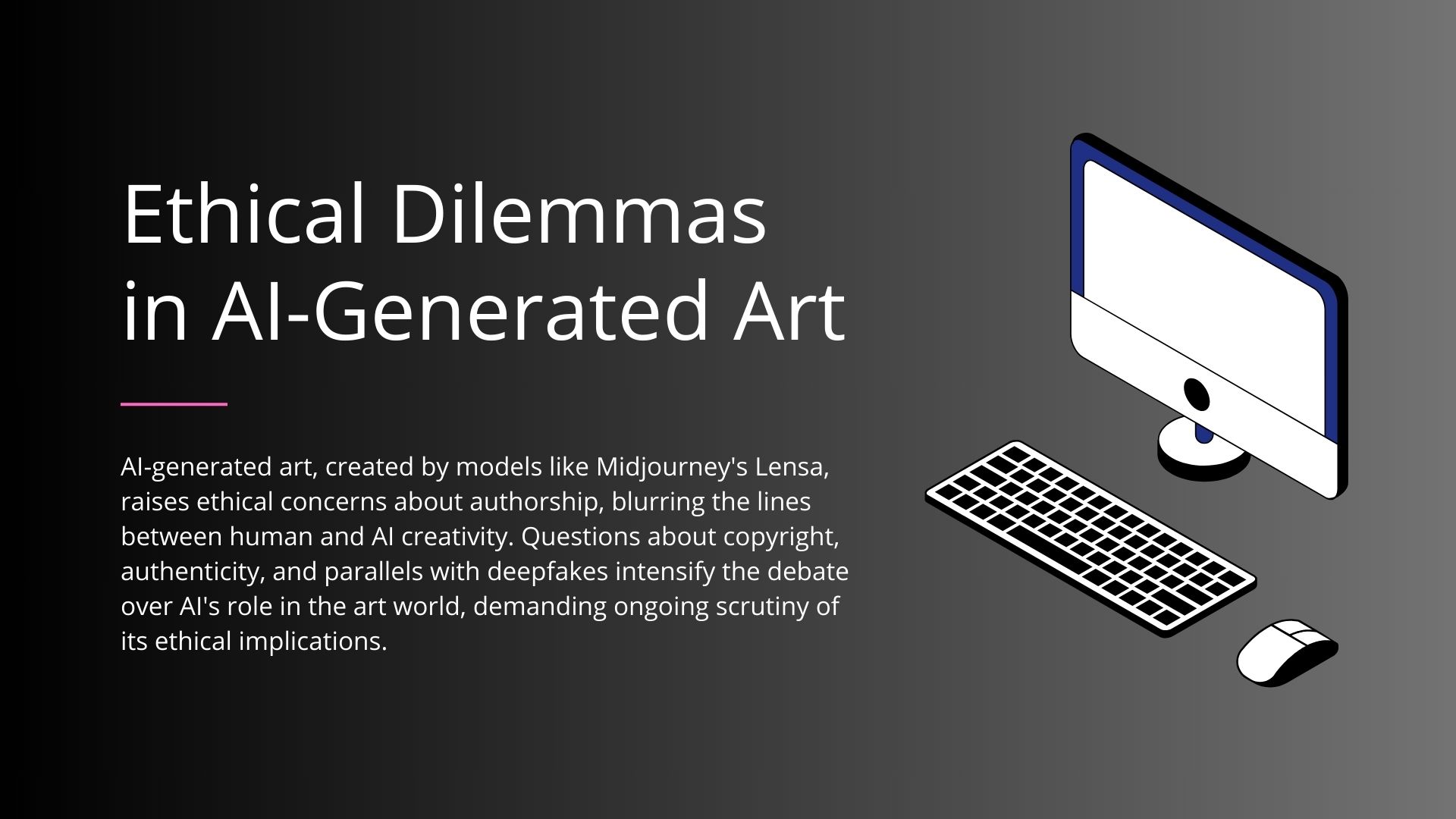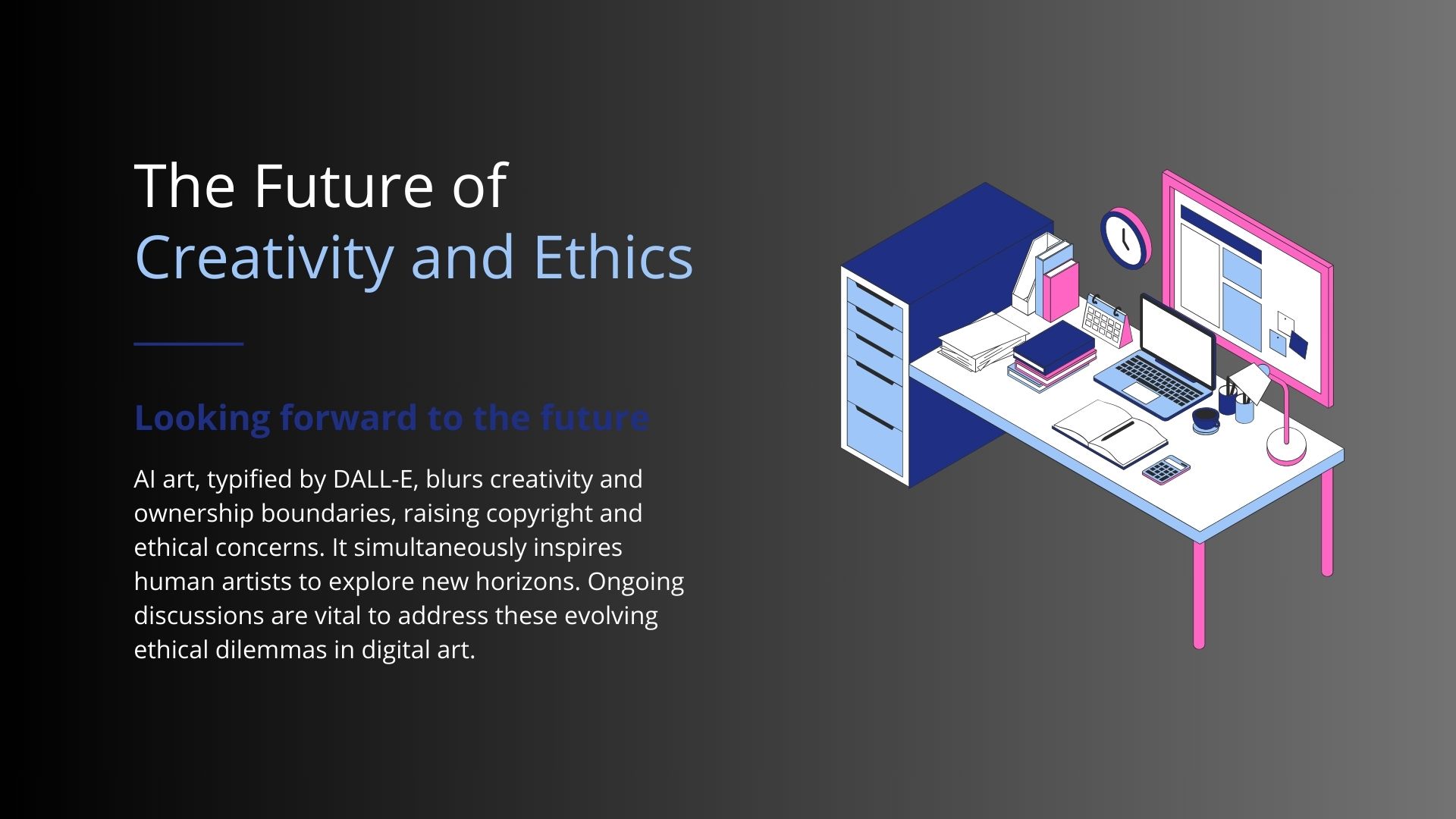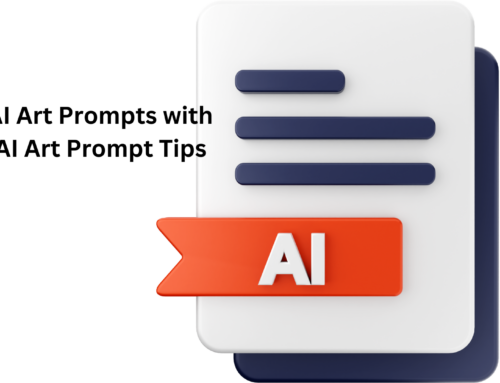Artificial Intelligence (AI) has made significant strides in the field of creative expression, giving rise to AI art generators that can produce stunning pieces of artwork. While AI-generated art has captivated the imagination of many, it has also raised important ethical and copyright concerns. In this article, we’ll delve into the ethical considerations and copyright issues surrounding AI art generators, with insights from two industry experts.

Is AI-Generated Art Redefining Ethics in the Art World?
When we step into the intriguing world of AI-generated art, it’s only natural to question the ethics of AI art that underpin this creative realm. The rise of AI-generated art, often created by powerful generative AI models like Midjourney’s Lensa, challenges the traditional boundaries of the art world. One of the pressing ethical concerns revolves around artists’ copyrights. Who truly owns a piece of art when it’s crafted by an AI system? Many artists argue that AI art blurs the lines of authorship and creativity. Furthermore, the stability AI brings to the visual arts industry is both a boon and a source of ethical issues. While it enables artists to explore new horizons, it also raises questions about art without the human touch. Some even draw parallels between AI-generated art and the controversial realm of deepfakes, further intensifying the debate over the ethics of AI technology’s use in the art world. As we journey further into this ethics of AI art landscape, it’s crucial to continue questioning the ethics and implications it carries, for artists and art enthusiasts alike.
Authorship and Creativity Questioning Ethics Of AI Art
One of the foremost ethical dilemmas revolves around the notion of authorship and creativity. Who should be credited as the creator of AI-generated art? Is it the AI itself, the programmer who designed it, or the user who initiated the process?
Abhishek Shah, The Founder of Testlify, offers his perspective: “AI art generators have undeniably ignited profound discussions within the art world regarding copyright, ownership, and the artist’s role. These conversations have culminated in emerging legal frameworks.
Primarily, AI-generated art challenges traditional notions of authorship and ownership. It raises questions about whether the creator is the artist, the programmer, or the AI itself. This ambiguity necessitates legal adaptations to define ownership clearly.
Ethical challenges abound as AI blurs the lines between original and derivative art. Issues concerning intellectual property and artistic authorship emerge when AI draws from copyrighted material or replicates an artist’s style. Striking a balance between fostering creativity and protecting intellectual property is a critical ethical concern.
In response, the art world is adapting with new legal precedents and discussions surrounding AI-generated art. Legal frameworks are being established to protect both artists and AI creators while acknowledging the uniqueness of AI-generated works. Ethical guidelines are emerging to promote transparency and proper attribution.
AI art generators have spurred necessary dialogues and legal developments, shaping a more nuanced understanding of creativity and ownership in the digital age.”
Exploring Ethical Concerns Prompted by AI Artistry
In the ever-evolving realm of digital art, the emergence of AI art generators like DALL-E in 2022 has prompted intriguing implications for the creative landscape. As we delve into the intriguing world of AI-generated images, it’s crucial to acknowledge the ethical concerns that arise. Here are five key points to consider:
- Human Artist Collaboration: The use of AI in art blurs the line between human artists and algorithms, raising questions about authorship and creative ownership.
- Copyright Laws: The application of machine learning to create digital art challenges existing copyright laws. Who owns the rights to AI-generated artwork – the creator or the machine?
- Stable Diffusion: With advancements like “Stable Diffusion,” AI-generated art becomes more sophisticated, potentially mimicking the styles of established artists. Is this a form of plagiarism?
- Promotion of Creativity: On the flip side, AI can prompt human artists to explore new frontiers and push their own creative boundaries.
- Ethical Choices: As consumers and creators, we must make ethical choices about the use of AI in art, considering its societal impact and the potential to devalue human creativity.
In the midjourney of AI artistry, it’s vital to engage in meaningful discussions about the ethical implications it presents for the future of digital art and the role of artificial intelligence in shaping our creative landscape.

Responsible Artificial Intelligence Practices in the Art World
Firstly, let’s talk about the responsibility businesses bear when utilizing AI for art. Just as we expect artists to create ethically, businesses must ensure that the AI algorithms they deploy are designed with ethical guidelines. Gabrielle Marie Yap, Senior Editor & Culinary Entrepreneur at CarnivoreStyle, emphasizes, “First and foremost, it’s important for businesses to be open and honest about how they use AI in their art. People love authenticity, and being honest about how AI is involved in the creative process helps build trust. I always emphasize how AI adds to our artistic vision, not takes away from it – it’s an asset, not a substitute for human creativity.
Another key aspect is respecting intellectual property and ensuring that the AI tools used don’t infringe on the work of other artists. Copyright issues can be a slippery slope, so it’s wise for businesses to stay vigilant and employ AI responsibly. As a culinary entrepreneur, I draw parallels to the culinary world, where sourcing ingredients ethically is fundamental. Similarly, businesses using AI in art should ensure they’re not inadvertently taking shortcuts that compromise the integrity of the creative landscape.
Lastly, the impact on employment in the arts sector is an ethical consideration that concerns me. While AI improves creativity, it is critical to maintain a balance and not completely replace human artists. Businesses should look into how AI can work with artists to create a mutually beneficial synergy. By assisting rather than replacing the artistic community, we help to ensure a more ethical and sustainable future for AI in commercial art. It’s all about striking a delicate balance between technological innovation and human touch.”
Transparency is another key player in the ethical game. When a piece of art is created by AI, it’s crucial for businesses to be transparent about it. C.L. Mike Schmidt, Lawyer at Schmidt & Clark LLP, notes, “AI has the ability to generate art by learning from a vast array of existing works. However, it’s crucial to ensure that this process doesn’t infringe on the rights of original artists. Businesses should be transparent about the use of AI and ensure they have the necessary permissions to use existing works for training AI models. This is not just a legal requirement, but also a matter of ethical responsibility.
The impact on human artists is another significant consideration. Art is a form of human expression, a reflection of the artist’s thoughts, feelings, and experiences. While AI can create art, it’s important to remember that it doesn’t have these human experiences. The commercial use of AI-generated art could potentially devalue the work of human artists or lead to job displacement. Therefore, businesses should strive to use AI in a way that complements human artists, rather than replacing them. This could involve using AI as a tool to assist artists or to create new forms of collaborative art.
Finally, there is the question of accountability. What happens if an AI creates a controversial or offensive piece of art? This is a thorny issue with legal and ethical ramifications. Businesses need to have robust policies in place to deal with such situations. They also need to be prepared to accept responsibility for the outcomes of their AI systems’ work. This includes being prepared to deal with any potential backlash or controversy that might result from the AI’s art creation.”
Is AI Reshaping Art Ethically? Let’s Discuss!
AI-generated images are raising significant ethical questions in the future of art. As technology evolves, three artists from DeviantArt are using OpenAI’s publicly available text-to-image AI to generate images. They’re not alone; multiple artists are exploring the merits of AI creations. However, this sparks concerns about intellectual property, as AI’s nature makes it challenging to pinpoint its true origin. Some argue that scraping artists’ works, like using them to train AI, may lead to a backlash in the art community. Still, the issue is not unique, as the ever-evolving nature of art continues to get intertwined with the capabilities of AI. So, how can we use AI in an ethical way while respecting the real artists behind the creations?
Ethical Guidelines for Harnessing the Power of Text-to-Image AI in Art
Art and AI, an unlikely duo reshaping creativity. But, as we venture into this realm, ethical questions loom large. How can AI craft images from words while respecting copyrights and pushing creative boundaries? Let’s dive into the ethical depths of text-to-image AI and explore the future of art.
Here are five points on how to use text-to-image AI ethically while respecting real artists and considering the use of copyrighted works:
- Respect Copyrighted Works: Always ensure that any copyrighted images used as part of the AI training data are obtained legally and with proper permissions. This is crucial to avoid issues of copyright infringement.
- Accuracy in Generation: Evaluate the AI’s ability to accurately generate images. The ethical use of text-to-image AI entails producing high-quality, original artworks rather than mere reproductions of existing images.
- Transparency and Attribution: Clearly attribute AI-generated artworks to the technology used to create them. Acknowledging the AI’s role in the creative process is important. For instance, “AI-art generated by GPT-3 as of January 2023.”
- Push Creative Boundaries: Although AI art is still in its infancy, it offers exciting creative possibilities. Encourage artists like Greg Rutkowski to collaborate with AI to create something new, expanding the boundaries of artistic expression.
- Explore NFTs and Ethical Usage: Explore ethical ways to integrate AI-generated art into the world of NFTs (Non-Fungible Tokens). Artists can tokenize AI-generated works, providing opportunities for compensation and recognition for both the AI and human creators while addressing any ethical issues surrounding ownership and authenticity.
By respecting copyrights, maintaining accuracy, practicing transparency, pushing creative boundaries, and exploring ethical NFT usage, we can harness the potential of text-to-image AI while respecting the rights and interests of real artists.

Airbrush AI: Where Technology Meets Artistry
Airbrush AI, the beacon of innovation in the world of art, illuminates the path where ethics meet technology. In a realm where AI technology reigns supreme, art raises profound questions about its creation. This prompt-based AI by Airbrush, like no another AI, paints a mesmerizing picture of the future. With every stroke, it challenges the very fabric of the ethics of AI art, pushing the boundaries of what’s possible. As we delve into the mesmerizing world of AI images, let’s embark on a journey that explores the delicate dance between artistry and artificial intelligence. The canvas is digital, but the possibilities are limitless, and the future of art is a masterpiece in the making. we’ll explore the five key features and uses of Airbrush AI, where technology becomes a canvas for generating art, and where the possibilities are as vast as the dataset it’s trained on.
- Generating Art with Precision: Airbrush AI is a powerful tool that can create art from simple descriptions or text prompts. It’s like having an artist at your fingertips, but this artist is a machine.
- Trained on Diverse Information: Airbrush AI is trained on a vast dataset, which means it has learned from a wide variety of art styles and images. It’s like having an artist who has studied countless paintings to perfect its craft.
- Where AI Gets Creative: When you use Airbrush AI, you’re tapping into the creative capabilities of artificial intelligence. It’s like having an AI art assistant that can bring your ideas to life.
- A Blend of Technology and Artistry: Airbrush AI combines the power of a machine learning model with the finesse of artistry. It’s like having a blend of science and creativity on your canvas.
- Endless Possibilities: With Airbrush AI, the possibilities for generating art are virtually limitless. You can create anything from realistic landscapes to imaginative scenes. It’s like having an infinite palette of artistic potential at your disposal.






Leave A Comment